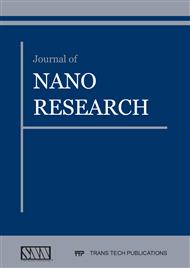[1]
P. Harris, F. Viliani, Strategic health assessment for large scale industry development activities: An introduction, Environ. Impact Assess. Rev. 68 (2018) 59-65.
DOI: 10.1016/j.eiar.2017.10.002
Google Scholar
[2]
A.L. Allison, Hazardous Materials and Wastewater: Treatment, Removal and Analysis, Nova Science Publishers, Inc., New York, (2017).
Google Scholar
[3]
E. Beutler, P. Lee, Molecular Diagnostics. Academic Press, San Diego, (2010).
Google Scholar
[4]
M. Jing, R. Liu, W. Yan, X. Tan, Y. Chen, Investigations on the effects of Cu2+ on the structure and function of human serum albumin. Luminescence 31 (2016) 557-564.
DOI: 10.1002/bio.2995
Google Scholar
[5]
D. Vadim, S. Anatoliy, Y. Vladimir, The effect of Cu2+ on ion transport systems of the plant cell plasmalemma. Plant Physiol. 114 (1997) 1313-1325.
DOI: 10.1104/pp.114.4.1313
Google Scholar
[6]
J.L. Gollan, A.T. Hewlett, Handbook of Liver Disease. 3rd ed., W.B. Saunders, Philadelpia, (2012).
Google Scholar
[7]
N. Murphy, Critical Care Medicine. 3rd ed., Philadelphia, (2008).
Google Scholar
[8]
D.G. Barceloux, D. Barceloux, Chromium. J. Toxicol. Clin. Toxicol. 37 (1999) 173-194.
Google Scholar
[9]
D. Mohan, H. Kumar, A. Sarswat, M. Alexandre-Franco, C.U. Pittman, Cadmium and lead remediation using magnetic oak wood and oak bark fast pyrolysis bio-chars. Chem. Eng. J. 236 (2014) 513–528.
DOI: 10.1016/j.cej.2013.09.057
Google Scholar
[10]
M.S. Chiou, G.S. Chuang, Competitive adsorption of dye metanil yellow and RB15 in acid solutions on chemically cross-linked chitosan beads. Chemosphere 62 (2006) 731-740.
DOI: 10.1016/j.chemosphere.2005.04.068
Google Scholar
[11]
K.M. Ajay, Smart Materials for Waste Water Applications. John Wiley & Sons, (2016).
Google Scholar
[12]
S. Brundavanam, G.E.J. Poinern, D. Fawcett, Kinetic and adsorption behaviour of aqueous Fe(II), Cu(II) and Zn(II) using a 30 nm hydroxyapatite based powder synthesized via a combined ultrasound and microwave based technique. Am. J. Mat. Sci. 5 (2015) 31-40.
Google Scholar
[13]
S.B. Chen, Y.B. Ma, L. Chen, K. Xian, Adsorption of aqueous Cd(II), Pb(II), Cu(II) ions by nano-hydroxyapatie: Single and multi-metal competitive adsorption study. Geochem. J. 44 (2010) 223-239.
DOI: 10.2343/geochemj.1.0065
Google Scholar
[14]
Y. Nishiyama, T. Hanafusa, J. Yamashita, Y. Yamamoto, T. Ono, Adsorption and removal of strontium in aqueous solution by synthetic hydroxyapatite. J. Radioanal. Nucl. Chem. 307 (2016) 1279-1285.
DOI: 10.1007/s10967-015-4228-9
Google Scholar
[15]
G.N. Kousalya, M.R. Gandhi, S. Meenakshi, Removal of Toxic Cr(VI) Ions from Aqueous Solution Using Nano-Hydroxyapatite-Based Chitin and Chitosan Hybrid Composites. Adsorp. Sci. Technol. 28 (2010) 49-64.
DOI: 10.1260/0263-6174.28.1.49
Google Scholar
[16]
V.T. Le, V.D. Doan, C.N. Phuc, A.M. Trubisin, Synthesis of Calcium-Deficient Carbonated Hydroxyapatite as Promising Sorbent for Removal of Lead Ions. J. Nano Res. 45 (2016) 124-133.
DOI: 10.4028/www.scientific.net/jnanor.45.124
Google Scholar
[17]
I. Mobasherpour, E. Salahi, M. Pazouki, Comparative of the removal of Pb(II), Cd(II) and Ni(II) by nano crystallite hydroxyapatite from aqueous solutions: Adsorption isotherm study. Arab. J. Chem. 5 (2012) 439-446.
DOI: 10.1016/j.arabjc.2010.12.022
Google Scholar
[18]
S. Park, A. Gomez-Flores, Y.S. Chung, H. Kim, Removal of Cadmium and Lead from Aqueous Solution by Hydroxyapatite/Chitosan Hybrid Fibrous Sorbent: Kinetics and Equilibrium Studies. J. Chem. 2015, 12.
DOI: 10.1155/2015/396290
Google Scholar
[19]
Y. Sekine, R. Motokawa, N. Kozai, T. Ohnuki, D. Matsumura, T. Tsuji, R. Kawasaki, K. Akiyoshi, Calcium-deficient Hydroxyapatite as a Potential Sorbent for Strontium. Sci. Rep. 7 (2017) (2064).
DOI: 10.1038/s41598-017-02269-z
Google Scholar
[20]
Y. Lei, J.J. Guan, W. Chen, Q.F. Ke, C.Q. Zhang, Y.P. Gou, Fabrication of hydroxyapatite/chitosan porous materials for Pb(II) removal from aqueous solution. RSC Adv. 5 (2015) 25462-25470.
DOI: 10.1039/c5ra01628b
Google Scholar
[21]
S. Jebri, I. Khattech, M. Jemal, Standard enthalpy, entropy and Gibbs free energy of formation of «A» type carbonate phosphocalcium hydroxyapatites. J. Chem. Thermodyn. 106 (2017) 84-94.
DOI: 10.1016/j.jct.2016.10.035
Google Scholar
[22]
S. Isabel, Overall Aspects of Non-Traditional Glasses: Synthesis, Properties and Applications, Bentham Science Publishers, (2016).
Google Scholar
[23]
Z. Shen, Y. Zhang, O. McMillan, F. Jin, A. Al-Takkaa, Characteristics and mechanisms of nickel adsorption on biochars produced from wheat straw pellets and rice husk. Environ. Sci. Pollut. Res. 24 (2017) 12809-12819.
DOI: 10.1007/s11356-017-8847-2
Google Scholar
[24]
N. Gupta, A.K. Kushwaha, M.C. Chattopadhyaya, Adsorptive removal of Pb2+, Co2+ and Ni2+ by hydroxyapatite/chitosan composite from aqueous solution. J. Taiwan Inst. Chem. Eng. 43 (2012) 125-131.
DOI: 10.1016/j.jtice.2011.07.009
Google Scholar
[25]
I. Mobasherpour, E. Salahi, M. Pazouki, Removal of nickel (II) from aqueous solutions by using nano-crystalline calcium hydroxyapatite. J. Saudi Chem. Soc. 15 (2011) 105-112.
DOI: 10.1016/j.jscs.2010.06.003
Google Scholar
[26]
B. Sridevi, E.J.P. Gérrard, F. Derek, Kinetic and Adsorption Behaviour of Aqueous Fe(II), Cu(II) and Zn(II) using a 30 nm Hydroxyapatite Based Powder Synthesized via a Combined Ultrasound and Microwave Based Technique. Am. J. Mater. Sci. 5 (2015) 31-40.
Google Scholar
[27]
S.A. Abo-El-Enein, H.A. El-boraey, R.M. El-korashy, A.A. Sery, Synthesis and characterization of nanohydroxyapatite and its application. Nature and Science 15 (2017) 96-104.
Google Scholar
[28]
G.M. Rajiv, G.N. Kousalyab, S. Meenakshia, Removal of copper(II) using chitin/chitosan nano-hydroxyapatite composite. Int. J. Biol. Macromol. 48 (2011) 119–124.
DOI: 10.1016/j.ijbiomac.2010.10.009
Google Scholar
[29]
F. Fernane, S. Boudia, F. Aiouache, Removal Cu(II) and Ni(II) by natural and synthetic hydroxyapatites: a comparative study. Desalin. Water Treat. 52 (2014) 2856-2862.
DOI: 10.1080/19443994.2013.807084
Google Scholar
[30]
V. Gopalakannan, N. Viswanathan, Development of Nano-Hydroxyapatite Embedded Gelatin Biocomposite for Effective Chromium(VI) Removal. Ind. Eng. Chem. Res. 54 (2015) 12561-12569.
DOI: 10.1021/acs.iecr.5b01224
Google Scholar
[31]
S. Hokkanen, A. Bhatnagar, E. Repo, E. Repo, S. Lou, M. Sillapapa, Calcium hydroxyapatite microfibrillated cellulose composite as a potential adsorbent for the removal of Cr(VI) from aqueous solution. Chem. Eng. J., 283 (2016) 445-452.
DOI: 10.1016/j.cej.2015.07.035
Google Scholar


